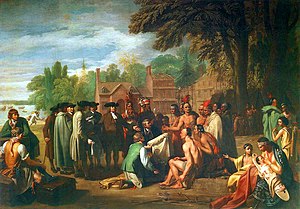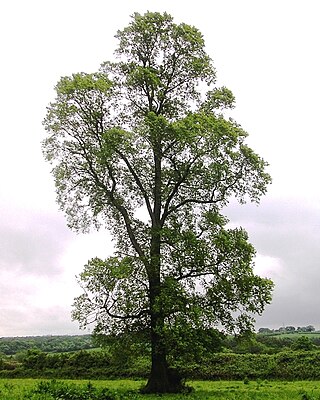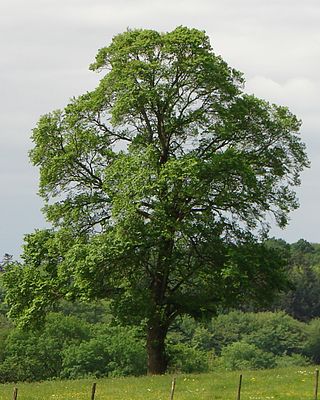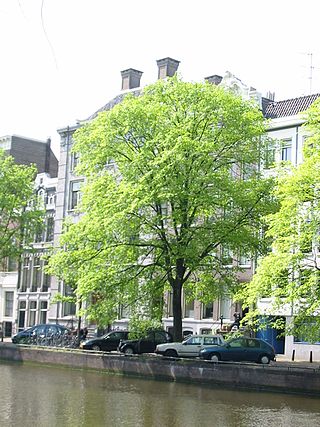American Elm Ulmus americana
Most of North America's notable elms are Ulmus americana , a fast-growing and long-lived species capable of attaining great size in a few centuries, especially when open-grown. [1] American Forests, a non-profit conservation organization, uses the following formula to calculate a point score for each tree to permit comparisons with others:
Trunk Circumference (in inches) + Height (in feet) + 1/4 Average Crown Spread (in feet) = Total Points [2]
State champion American elm trees
The list of United States state champion American elm trees below tabulates each of the above characteristics, as well as the total points awarded to each tree.
| State | Location | Circumference | Height | Average Crown Spread | Total Points | Year | Ref. |
|---|---|---|---|---|---|---|---|
| Alabama | Walker County | 194 inches (490 cm) | 92 feet (28 m) | 84 feet (26 m) | 307 | 2018 | [3] |
| Arkansas | On the east side of Arkansas Highway 77 just east of the intersection of Highway 77 and Arkansas Highway 136, two miles north of Athelstan (intersection of Arkansas Highway 140 and Highway 77), Mississippi County | 251 inches (640 cm) | 112 feet (34 m) | 107 feet (33 m) | 390 | [4] | |
| California | San Jose, Santa Clara County | 173 inches (440 cm) | 89 feet (27 m) | 68 feet (21 m) | 279 | 2015 | [5] |
| Colorado | Denver | 205.67 inches (522.4 cm) | 110 feet (34 m) | 107 feet (33 m) | 342.42 | [6] | |
| Colorado | Olney Springs, Crowley County | 208.18 inches (528.8 cm) | 97 feet (30 m) | 82 feet (25 m) | 325.68 | [6] | |
| Colorado | Fort Collins, Larimer County | 194.68 inches (494.5 cm) | 96 feet (29 m) | 95 feet (29 m) | 314.43 | [6] | |
| Colorado | Fort Morgan, Morgan County | 209.12 inches (531.2 cm) | 75 feet (23 m) | 106 feet (32 m) | 310.62 | [6] | |
| Connecticut | Greenwich, Fairfield County | 230 inches (580 cm) | 106 feet (32 m) | 98 feet (30 m) | 360 | 2019 | [7] |
| Delaware | The Green, Dover, Kent County | 226 inches (570 cm) | 113 feet (34 m) | 104 feet (32 m) | 367 | [8] | |
| Delaware | White Clay Creek State Park, Newark, New Castle County | 213 inches (540 cm) | 113 feet (34 m) | 81 feet (25 m) | 346 | [8] | |
| Delaware | 1191 Boyds Corner Road, Middletown, New Castle County | 199 inches (510 cm) | 75 feet (23 m) | 125 feet (38 m) | 305 | [8] | |
| Florida | Duval County | 192 inches (490 cm) | 77 feet (23 m) | 51.5 feet (15.7 m) | 282 | 2016 | [9] |
| Georgia | Norcross, Gwinnett County | 233 inches (590 cm) | 80 feet (24 m) | 125 feet (38 m) | 344 | 2016 | [10] |
| Georgia | Atlanta, Fulton County | 191 inches (490 cm) | 91 feet (28 m) | 125 feet (38 m) | 313 | 2011 | [11] |
| Idaho | Emmett, Gem County | 180 inches (460 cm) | 98 feet (30 m) | 88 feet (27 m) | 300 | 1998 | [12] |
| Illinois | Edwardsville, Madison County | 189.6 inches (482 cm) | 114 feet (35 m) | 103 feet (31 m) | 329 | 2007 | [13] |
| Indiana | Parke County | 245.6 inches (624 cm) | 108 feet (33 m) | 127 feet (39 m) | 385.35 | [14] | |
| Iowa | East of Liberal Arts Building, University of Iowa, Iowa City, Johnson County | 194 inches (490 cm) | 93 feet (28 m) | 98.5 feet (30.0 m) | 311.25 | [15] | |
| Kentucky | Jackson, Breathitt County | 224.5 inches (570 cm) | 111 feet (34 m) | 113.5 feet (34.6 m) | 363.88 | 2011 | [16] |
| Louisiana ( National champion ) | Iberville Parish | 324 inches (820 cm) | 111 feet (34 m) | 79 feet (24 m) | 455 | 2010 | [17] |
| Maine | Yarmouth, Cumberland County (removed in 2010 due to Dutch elm disease) | 244 inches (620 cm) | 110 feet (34 m) | 129 feet (39 m) | 386 | 2006 | [18] [19] |
| Massachusetts | Main Street, Old Deerfield, Franklin County (removed in 2017 due to Dutch elm disease) | 230.4 inches (585 cm) | 104.4 feet (31.8 m) | 103.6 feet (31.6 m) | 360.7 | 2016 | [20] |
| Massachusetts | Main Street — Bridge Lane, Hatfield, Hampshire County | 204 inches (520 cm) | 86 feet (26 m) | 95 feet (29 m) | 314 | 2016 | [20] |
| Michigan | 6022 East O Avenue, Kalamazoo, Kalamazoo County | 264 inches (670 cm) | 110 feet (34 m) | 122.5 feet (37.3 m) | 405 | 2019 | [21] |
| Minnesota | Hennepin County near Minneapolis | 228 inches (580 cm) | 80 feet (24 m) | 87 feet (27 m) | 329.75 | 2010 | [22] |
| Missouri | Johnson County | 236 inches (600 cm) | 85 feet (26 m) | 126 feet (38 m) | 353 | [23] | |
| Montana | Ravalli County | 205 inches (520 cm) | 74 feet (23 m) | 83 feet (25 m) | 300 | 2012 | [24] |
| Montana | Ravalli County | 186 inches (470 cm) | 95 feet (29 m) | 65 feet (20 m) | 297 | 2012 | [24] |
| Montana | Lewis and Clark County | 182 inches (460 cm) | 83 feet (25 m) | 26 feet (7.9 m) | 291 | 2019 | [24] |
| Nebraska | Near Idylwild Park in Lincoln, Lancaster County | 222 inches (560 cm) | 70 feet (21 m) | 85 feet (26 m) | 313.25 | 2019 | [25] |
| Nevada | Idlewild Park, Reno, Washoe County | 127 inches (320 cm) | 86 feet (26 m) | 81 feet (25 m) | 233 | [26] | |
| New Hampshire | Dover, Strafford County | 167 inches (420 cm) | 100 feet (30 m) | 84.5 feet (25.8 m) | 288 | 2018 | [27] |
| New Jersey | Stevens Institute of Technology, Hoboken, Hudson County | 207 inches (530 cm) | 90 feet (27 m) | 107 feet (33 m) | 324 | [28] | |
| New Jersey | Union County | 178 inches (450 cm) | 115 feet (35 m) | 86 feet (26 m) | 315 | [28] | |
| New Mexico | Philmont Scout Ranch, near Cimarron, Colfax County | 240 inches (610 cm) | 79 feet (24 m) | 91 feet (28 m) | 342 | 2010 | [29] |
| New York | Fulton County | 188 inches (480 cm) | 140 feet (43 m) | 200 feet (61 m) | 353 | 2015 | [30] |
| North Carolina | Powellsville, Bertie County | 229 inches (580 cm) | 135 feet (41 m) | 87 feet (27 m) | 385 | [31] | |
| North Dakota | 1012 Ninth Street South, Fargo, Cass County | 196 inches (500 cm) | 87 feet (27 m) | 98.5 feet (30.0 m) | 308 | 2016 | [32] |
| North Dakota | Rose Street, Lisbon, Ransom County | 211 inches (540 cm) | 58 feet (18 m) | 100 feet (30 m) | 294 | 2016 | [32] |
| Ohio | Hamilton County | 262 inches (670 cm) | 101 feet (31 m) | 83 feet (25 m) | 383 | 2016 | [33] |
| Oklahoma | Pawhuska, Osage County | 201 inches (510 cm) | 66 feet (20 m) | 90 feet (27 m) | 290 | 2013 | [34] |
| Oregon | 212 inches (540 cm) | 120 feet (37 m) | 83 feet (25 m) | 353 | [35] | ||
| Pennsylvania | 1 Jackson Street, Wellsboro, Tioga County | 232 inches (590 cm) | 108 feet (33 m) | 115 feet (35 m) | 369 | 2017 | [36] |
| Rhode Island | Providence | 195 inches (500 cm) | 95 feet (29 m) | 88 feet (27 m) | 312 | [37] | |
| South Carolina | Richland County | 272 inches (690 cm) | 107 feet (33 m) | 114 feet (35 m) | 405 | [38] | |
| South Carolina | Richland County | 225 inches (570 cm) | 121 feet (37 m) | 105 feet (32 m) | 372.25 | [38] | |
| South Carolina | Oconee County | 151 inches (380 cm) | 99 feet (30 m) | 80 feet (24 m) | 270 | [38] | |
| South Dakota | Lyman County, near Chamberlain, Brule County | 201 inches (510 cm) | 53 feet (16 m) | 92 feet (28 m) | 277 | [39] | |
| Tennessee | Meeman-Shelby Forest State Park, Shelby County | 277 inches (700 cm) | 122 feet (37 m) | 84 feet (26 m) | 420 | 2001 | [40] |
| Texas | Grayson County | 232 inches (590 cm) | 75 feet (23 m) | 116 feet (35 m) | 336 | 2017 | [41] |
| Utah | 195 South 100 East Street, Logan, Cache County | 190 inches (480 cm) | 98 feet (30 m) | 84 feet (26 m) | 309 | 2007 | [42] |
| Vermont | Saxtons River, Windam County | 201 inches (510 cm) | 124 feet (38 m) | 110 feet (34 m) | 352 | [43] | |
| Virginia | Along the Potomac River in Great Falls, Fairfax County | 240 inches (610 cm) | 130 feet (40 m) | 105 feet (32 m) | 396 | 2015 | [44] |
| Virginia | 200 N. George Washington Highway, Deep Creek, City of Chesapeake | 252 inches (640 cm) | 110 feet (34 m) | 116 feet (35 m) | 391 | 2018 | [44] |
| Washington | 215 inches (550 cm) | 105 feet (32 m) | 99 feet (30 m) | 345 | [45] | ||
| West Virginia | Near Rippon, Jefferson County | 279 inches (710 cm) | 102 feet (31 m) | 70 feet (21 m) | 398 | [46] | |
| West Virginia | Near Linden, Roane County | 219 inches (560 cm) | 77 feet (23 m) | 86 feet (26 m) | 317 | [46] | |
| Wisconsin | On Rock Road east of Greenwood Road, Outagamie County | 228 inches (580 cm) | 105 feet (32 m) | 70 feet (21 m) | 351 | 2004 | [47] |
| Wisconsin | 1040 Terrace Drive, Elm Grove, Waukesha County | 192 inches (490 cm) | 135 feet (41 m) | 79 feet (24 m) | 346.75 | 2013 | [47] |
| Wisconsin | Street tree between 1284 and 1288 North 71st Street, east side of Hart Park, Wauwatosa, Milwaukee County | 179 inches (450 cm) | 145 feet (44 m) | 87 feet (27 m) | 345.75 | 2007 | [47] |
Other lists of American elm trees
Other notable American elm trees include:

- The Treaty Elm, Philadelphia, Pennsylvania. In what is now Penn Treaty Park, the founder of Pennsylvania, William Penn, is said to have entered into a treaty of peace in 1683 with the native Lenape Turtle Clan under a picturesque elm tree immortalized in a painting by Benjamin West. West made the tree, already a local landmark, famous by incorporating it into his painting after hearing legends (of unknown veracity) about the tree being the location of the treaty. No documentary evidence exists of any treaty Penn signed beneath a particular tree. On 6 March 1810 a great storm blew the tree down. Measurements taken at the time showed it to have a circumference of 24 feet (7.3 m), and its age was estimated to be 280 years. Wood from the tree was made into furniture, canes, walking sticks and various trinkets that Philadelphians kept as relics.
- The Washington Elm, Cambridge, Massachusetts. George Washington is said to have taken command of the American Continental Army under the Washington Elm in Cambridge on 3 July 1775. The tree survived until the 1920s and "was thought to be a survivor of the primeval forest". In 1872, a large branch fell from it and was used to construct a pulpit for a nearby church. [48] The tree, an American White Elm, became a celebrated attraction, with its own plaque, a fence constructed around it and a road moved in order to help preserve it. [49] The tree was cut down (or fell – sources differ) in October 1920 after an expert determined it was dead. The city of Cambridge had plans for it to be "carefully cut up and a piece sent to each state of the country and to the District of Columbia and Alaska," according to The Harvard Crimson . [50] As late as the early 1930s, garden shops advertised that they had cuttings of the tree for sale, although the accuracy of the claims has been doubted. A Harvard "professor of plant anatomy" examined the tree rings days after the tree was felled and pronounced it between 204 and 210 years old, making it at most 62 years old when Washington took command of the troops at Cambridge. The tree would have been a little more than 2 feet (0.61 m) in diameter (at 30 inches (760 mm) above ground) in 1773. [51] In 1896, an alumnus of the University of Washington obtained a rooted cutting of the Cambridge tree and sent it to Professor Edmund Meany at the university. The cutting was planted, cuttings were then taken from it, including one planted on 18 February 1932, the 200th anniversary of the birth of George Washington, for whom Washington state is named. That tree remains on the campus of the Washington State Capitol. Just to the west of the tree is a small elm from a cutting made in 1979. [49]



- "Herbie" in Yarmouth, Maine, stood by present-day East Main Street (Route 88) from 1793 to 2010. [52] At 110 feet (34 m) in height, it was believed to be, between 1997 and the date of its felling, [53] the oldest [54] and tallest Ulmus americana in New England. [55] The tree, which partially stood in the front yard of a private residence, had a 20-foot (6.1 m) circumference and (until mid-2008) a 93-foot (28 m) crown spread. [55] As of 2003, only twenty of Yarmouth's original 739 elms had survived Dutch elm disease. [56] In August 2009 it was revealed that, after battling fifteen bouts of Dutch elm disease, the tree had lost, and on 19 January 2010 it was cut down. [57]
- The Liberty Tree, an elm on Boston Common in Boston, Massachusetts, was a rallying point for the growing resistance to the rule of England over the American colonies.
- The Great Elm on Boston Common, supposed to have been in existence before the settlement of Boston, at the time of its destruction by the storm of 15 February 1876 measured 22 ft (6.7 m) in circumference. [58] [59]
- George Washington's Elm, Washington, D.C. George Washington supposedly had a favorite spot under an elm tree near the United States Capitol Building from which he would watch construction of the building. The elm stood near the Senate wing of the Capitol building until 1948. [48]
- The Logan Elm stood near Circleville, Ohio. The 65-foot-tall (20 m) tree had a trunk circumference of 24 feet (7.3 m) and a crown spread of 180 feet (55 m). [60] Weakened by Dutch elm disease, the tree died in 1964 from storm damage. [60] The Logan Elm State Memorial commemorates the site and preserves various associated markers and monuments. [60] According to tradition, Chief Logan of the Mingo tribe delivered a passionate speech at a peace-treaty meeting under this elm in 1774, [60] said to be the most famous speech ever given by a Native American.[ citation needed ]
- The Sauble Elm. With a girth of 24 feet 9 inches (7.54 m) and a height of over 130 feet (40 m), the Sauble Elm, a white elm ( Ulmus americana ) which once grew beside the banks of the Sauble River between the towns of Hepworth and Sauble Beach in the county of Bruce in the province of Ontario, was one of the largest "wild" elms in North America. The tree succumbed to Dutch elm disease and was felled in 1968. A ring count established that it had begun life in the year 1701. [61]
- The "Great Elm Tree" at Phillips Academy in Andover, Massachusetts is believed to have been standing for at least 200 years. It is being well cared for and receives regular treatments for Dutch elm disease. [62]

- The Johnstown Elm, in Johnstown, New York, as of September 2013 did not show any signs of Dutch elm disease. In October 2018 all that remained was a weathered stump, cut perhaps two years earlier. It had a circumference of 196 inches (16.3 ft; 5.0 m), a height of 85 feet (26 m), and a crown of 88 feet (27 m). It grew in the front yard of a house in a small upstate city, and was probably over 200 years old. See photo at right.
- The Philipsburg Elm, Philipsburg, Quebec, was a 280-year-old 30-meter (98 ft)Ulmus americana, dubbed "the king of elms". It was cut down in March 2009 after death from Dutch elm disease. [63] [64]
- "Elmo", Brown University, Providence, Rhode Island, a large elm that "once defined the Thayer Street entrance to Brown's new Watson Institute for International and Public Affairs," contracted Dutch elm disease and was torn down in December 2003, according to a campus news release. The tree "was thought to have been between 80 and 100 years old. Wood from the tree, one of the largest on campus, was used in various student art projects." [65]
- The Association Island Elm, New York state. The General Electric think tank organization, the Elfun Society, founded in 1928 at Association Island in the Thousand Islands area of northern New York state, is named after a famous elm tree on the 65-acre (260,000 m2) isle. The tree died in the 1970s, but it survives in the elm tree logo still used by Elfun. [66]

- The Tabletop Elm in Provo, Utah. Immediately south of the Utah County Administration Building and just east of the Historic Utah County Courthouse in downtown Provo resides possibly a one-of-a-kind elm tree. Officially it is a specimen of Ulmus americana, but is unusual because it grows sideways, making it a "tabletop" elm tree. The tree was planted in 1927, and currently its several branches are supported by specialized braces to allow movement and growth. Every fall seven dump truck loads are required to remove all the leaves. Both reproduction and cloning efforts have been unsuccessful; the tree's seeds do not mature into the tabletop shape. [67] [68]
- New Haven, Connecticut, had the first public tree planting program in America, producing a canopy of mature trees (including some large elms) that gave New Haven the nickname "The Elm City". [69] This later gave rise to the Yale song, Neath the Elms.
- The current Tree Register of the British Isles (T.R.O.B.I.) champion American elm tree lives in Avondale Forest near Rathdrum, County Wicklow, Ireland. The tree had a height of 22.5 metres (74 ft) and a diameter at breast height of 98 centimetres (39 in) (circumference of 308 centimetres (121 in)) when measured in 2000. [70] The tree replaced on the Register a larger champion located in Woodvale Cemetery in Sussex, England, which in 1988 had a height of 27 metres (89 ft) and a diameter of 115 centimetres (45 in) (circumference of 361 centimetres (142 in)). [71]




















